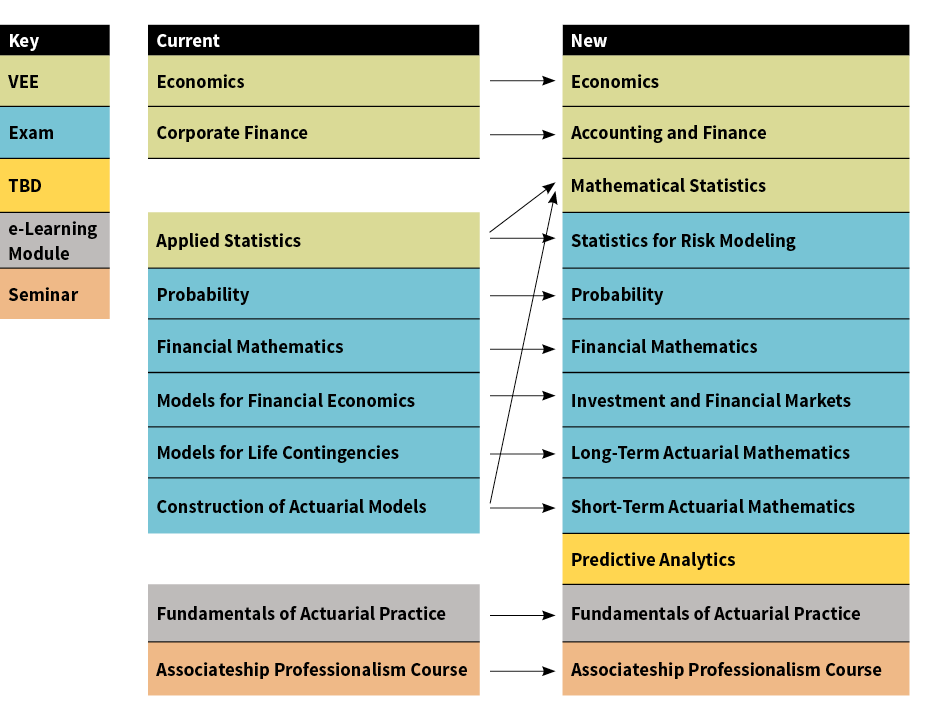Stages of Growth
How we got from 10 exams to here
October/November 2016Ask an actuary of a certain age or a person on the street how you become an actuary, and the answer is likely to be “pass a bunch of exams—10, I think.” Starting in 2018, the answer will be “to become an associate you must pass three validation by education experience courses, five multiple-choice exams, one exam that is a combination of multiple-choice and written-answer, a predictive analytics project, an online course with six end-of-module exercises and two assessments, and a seminar on professionalism; and then earn fellowship with four online modules, each with an exercise, three written-answer exams (or four, for some tracks), and a seminar on communication and professionalism.” This article will walk you through the history of the SOA’s qualification system so you can see how and why we got from where we were then to where we are now.
There are four distinct eras in SOA education history, each with a major change in how we educated and assessed prospective members. But before diving into that, it is worth noting two policies and a trend that have been consistent throughout the decades.
The first policy is that exam credits are never lost, unless the topic itself is removed from the pathway. Credits earned in prior systems are carried through each subsequent transition to reveal the credits a candidate currently possesses. For example, had I stopped exams with my ASA in 1970, today I would have credit for all of the current ASA requirements except the Fundamentals of Actuarial Practice (FAP) Course.
This leads to the second policy. While no member loses an ASA when the ASA requirements change, those changes can affect the path to FSA. When a person who has an ASA under a prior system wants to continue to FSA under a current system, the requirements are not only those that are in the current FSA part of the pathway. Rather, all missing components, be they ASA-level or FSA-level, must be completed. In my case, I would need to complete the FAP Course along with all current fellowship-level requirements to earn an FSA.
The trend is that as the profession advances, we expect more and more from our new members. Subjects once tested are now either assumed as prerequisites or no longer considered relevant. Examples include English, Calculus, Numerical Analysis, Operations Research, and Sources and Characteristics of Mortality Tables. In turn, we added Enterprise Risk Management, Asset/Liability Management, Stochastic Modeling and a host of track-specific advanced topics.
Now, on to the retrospective.
The 10-Exam Era
This period runs from the dawn of the profession through 1987–1988. There weren’t always exactly 10 examinations during this period.1 But there were definitely exams. The only differences were that some exams were exclusively multiple-choice, some exclusively written-answer and some a combination of both. The only innovation during all this time was the introduction of tracks in 1964.
Flexible Education System (FES)
From the spring 1987 exam session to the fall 1988 exam session, a radical change was instituted. Rather than a handful of large exams, the system was broken into numerous small pieces. Often, each was on a single topic. For example, Exam 5 was split into Exams 151 (Risk Theory), 160 (Survival Models), 162 (Construction of Actuarial Tables) and 165 (Mathematics of Graduation). Exams were assigned credit values based mostly on length. It took 200 credits to earn an ASA and 450 (total) to earn an FSA. Some exams were required, while others were elective. This was viewed as a college catalog approach—where the ASA was the general education core and the fellowship track the major. A candidate needed to complete about 25 exams to earn the 450 credits.
This era also saw the introduction of non-exam means of earning credit. Thirty elective credits could be earned by writing a research paper. Ten elective credits could be earned by passing a one-week intensive seminar (seminars in applied statistics and applied risk theory were available at this time). The other new element was the Fellowship Admissions Course (FAC), a multiday capstone seminar. Of these innovations, only the FAC exists today.
The benefits seemed clear at the time. With small pieces and electives, innovations like these could be added. Candidates would have more flexibility with their progress. Subjects no longer needed could more easily be dropped and new ones added. The results turned out a bit differently. Candidates tended to focus on only one or two exams at a time, as that provided the ability to over-study and increase the odds of passing something. Travel time increased, which was not a goal of the system. Also, exams were added, but few were subtracted. This put a strain on the volunteer system.
There was one major change during the FES era. In 1995, the requirement for ASA was increased to 300 credits. This meant ASAs had more than just the mathematical background; they also were introduced to each practice area, along with finance and investments.
The 2000 System
No, this was not a reaction to the Y2K problem. The SOA’s systems were perfectly capable of dealing with three-digit exam numbers. It was a reaction to the problems discovered with FES. So it was back to a small number of large exams. The FES innovations, other than the FAC, were dropped. Aside from recombining the exams, there were three major changes.
The big one was the removal of nation-specific material. The idea was that an FSA should represent a thorough grounding in actuarial principles at the highest level, but without coverage of how those principles are applied in a particular jurisdiction. As a simple example, the need for and the concept of modified reserves could be covered, but not the Commissioners Reserve Valuation Method. The expectation was that each local actuarial association would provide appropriate education to fill that gap, and it would become each actuary’s professional development responsibility to acquire that knowledge.
The second was the introduction of the Course 7 Seminar in Applied Modeling. This multiday seminar ended with a project and written report. It was similar to the intensive seminars developed in the FES era, but was mandatory.
Finally, while the Associateship Professionalism Course had been offered previously, this seminar on the Code of Conduct and Standards of Practice became mandatory in 2000.
History of SOA Fellowship Tracks
Life Insurance track: the only track prior to 1964
Employee Benefit Plans track: added in 1964
Group/Health track: added in 1981
Finance track: added in 1993
Investment track: added in 1995
General Insurance track: added in 2013
Today’s System
The reaction to the removal of nation-specific material was swift and strong. In late 2001, the SOA’s Board of Governors voted to return that material, expand the coverage of track-specific topics and make the system more relevant to actuarial practice. In 2003, after engaging many stakeholders and resolving numerous issues, the Board approved a set of revisions. They were rolled out in stages during 2005–2007.
That framework continues to be in use today. A key change was the introduction of a variety of learning and assessment methods, each designed to be appropriate for the given topic and learning objectives. Innovations included:
- Validation by educational experience: There is no SOA assessment; rather, a grade of B− or better must be earned in an approved university course or equivalent experience. This was deemed appropriate for subjects that do not require a high-hurdle exam or are not easily tested in multiple-choice or short written-answer environments.
- Computer-based tests: Multiple-choice tests delivered at a computer test center. Often, candidates receive unofficial (but highly reliable) pass/fail results upon completion of the test.
- e-Learning modules: Education is provided through an interactive online environment, and assessments are projects done offline.
- Communication skills: The e-Learning modules and the enhanced FAC provide opportunities to learn about and demonstrate effective oral and written communication.
This period saw the introduction of a new credential, Chartered Enterprise Risk Analyst (CERA). Originally, it was available only for candidates on the ERM track, but in 2013, the fellowship pathways were changed so that any candidate can earn a CERA by replacing a two-hour exam with a four-hour exam. It also saw the addition of the fellowship track in General Insurance, which means the SOA now offers education in all major practice areas.
The Future
The SOA Board of Directors approved the latest evolution of SOA education in June 2016. Starting in 2018, candidates earning an ASA will have had extensive education in predictive analytics. This will feature another education innovation, as this topic will be assessed with a large project to be completed using statistical software and done in a proctored environment. As employer expectations, candidate needs and the practice of actuarial science change, the SOA’s education system must change as well. I am eager to find out what is next.
The Future
This chart displays the transition rules between the components for the 2018 changes. More details are available at SOA.org/curriculumchanges.

References:
- 1. When I earned my FSA in 1978, there were nine exams. When I started taking exams, there were 10. As a result, I had to pass 13 exams. ↩

